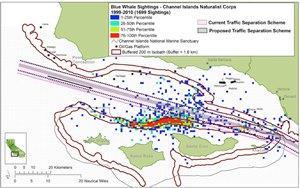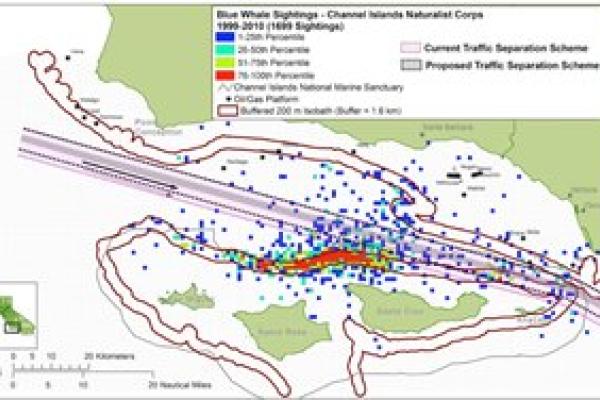
Sarah Nowak
Published: October 01, 2015

An excellent example of how industry and regulatory bodies can work with environmental activists to provide good results for the benefit of all.
Background
Blue, humpback, and fin whales are endangered species and are protected by the Endangered Species Act, the Marine Mammal Protection Act, and the National Marine Sanctuaries Act and every year, about 200 blue whales go to the Santa Barbara Channel and spend four to six months feeding on krill, which commonly congregate beneath shipping lanes.
In addition to pollution and hunting, for decades one of the biggest dangers to blue whales has been ship strike. These slow moving whales are historically vulnerable to ship strikes as their feeding and migration areas overlapped with shipping lanes. In 2007, four blue whales were killed by ship strikes in the Santa Barbara Channel alone. In 2010, two blue whales, one humpback whale, and two fin whales were killed in the San Francisco area and along the north-central California coast. It is also worth noting that the actual number of ship strikes in any given year is likely much greater, given that many ship strike go undetected because the whales sink or drift out of sight.
The plight of the blue whale has brought industry into collaboration with scientists and the regulators to solve the problem of possible extinction of these mammals. A 15 year project to tag and track the movements of blue whales highlighted their migration and feeding patterns. This project assisted in the redrawing of the shipping lanes to assist in the protection of the blue whales and other species.
Implementation
In November 2012, the International Maritime Organization (IMO), which governs shipping worldwide, adopted proposals to adjust shipping lanes along the Californian coast with the goal of protecting endangered whale species from ship strikes. The adjustments were adopted after substantial research was conducted by the United States National Oceanic & Atmospheric Administration (NOAA). Additionally, the United States Coast Guard (USCG) and the NOAA worked for two years to fine-tune the proposed traffic modification.
The IMO shifted lanes on the approaches to San Francisco Bay, San Barbara Channel (which runs from San Francisco to Long Beach/Los Angeles) and the ports of Long Beach & Los Angeles. Ships which pass through these areas come close to the Cordell Bank, the Gulf of Farallones and the Channel Islands, all of which are sanctuaries. It is hoped that narrowing the existing lanes and adjusting the busy lanes off the California coast that cross the three national sanctuaries would have a positive effect in reducing the number of whale strikes off the West Coast, where the estimated population of blue whales is 2,500.
The adjustments to shipping lanes were voluntarily implemented shortly thereafter by many operators in the San Francisco Bay, the Santa Barbara Channel, and the Ports of Los Angeles and Long Beach.
It was also recommended that speed reductions be put in place: this had two benefits. First emissions are substantially lower (some estimates suggest 50% lower) when a ship is operating at 12 knots or less rather than the standard cruising speed of 14-18 knots. Secondly, since whales are rather slow to react, the reduced speed gives them the opportunity to identify the danger of an oncoming vessel and take evasive action.
Close co-operation
A phone app was also developed for iPhone and iPad devices for use by crew members on deck watch, which in effect makes them whale spotters. This aids officials reporting the presence of whales to others vessels transiting those areas. Educational posters distributed to the shipping industry have also helped crews acting as spotters. Advisory zone charts and notices to mariners have been developed as well so that ships could be advised of sightings. Using vessels as whale sighting platforms is an exceptionally efficient and effective way to assist in the efforts to protect the environment and in particular, the whales.
“The collaboration between NOAA and the Coast Guard in reviewing and modifying these vessel traffic separation schemes demonstrates the strong working relationship between the two agencies. The modifications to traffic lanes balance the safe and efficient flow of commerce within and between our nation’s ports, with NOAA’s goal of reducing whale strikes from vessels.” (Rear Admiral Karl Schultz, 11th Coast Guard District Commander).
A win-win situation
NOAA has described the adjustments as a “win-win” in the sense that modification of shipping lanes to protect whales illustrates a real-world balance between commercial considerations and environmental concerns.
According to Sean Hastings, the Resource Protection Coordinator of NOAA, there have not been any additional updates to shipping lanes since the adoption of the lane adjustments in 2012, and while data is still being gathered to determine the efficacy of the measures, NOAA hopes to soon confirm a substantial decrease in the number of whale strikes. Furthermore, Mr. Hastings stated that a review of shipping traffic logs noted a “very high compliance with south bound ships using the new approach to the ports.” Although the lane adjustments are voluntary, it appears as though most vessel operators are buying in.
Furthermore, the IMO also believes the lane adjustments will increase vessel safety. According to the IMO, the lane extensions will keep commercial vessels on a dedicated route through prime fishing grounds, which will reduce the interaction between fishing vessels and commercial ships.
Proponents of the adjustment are hopeful that the data will confirm a substantial decrease in the number of ship strikes and the risk of future strikes.
Additional information can be found online at http://sanctuaries.noaa.gov.
We are grateful to James Marissen of Keesal, Young & Logan and Robert G Hanson of Lamorte Burns & Co., Inc. for their contribution to this article.


